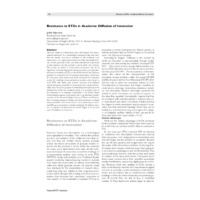Resistance to ETDs in Academe
Metadata
Resistance to ETDs in Academe
Electronic theses and dissertations are a technological and organizational innovation. As a technological innovation, they may redefine the content, structure or audience of the traditional print dissertation; as an organizational innovation, they may redefine faculty, student, graduate school, and library perceptions of graduate student research and the purposes it serves within the university. The inclusion of content in visual and/or audio form, the use of hyperlinks to provide alternative reading structures, and the potential broad accessibility of ETDs via the WWW are all "new" features typically not associated with the writing of dissertations, which have for many years been almost exclusively text-based. As universities accept the challenge of accommodating students who choose to write ETDs that reflect new content, structure, and audience choices previously unavailable to seasoned faculty, change will inevitably occur. Part of my purpose in researching and reporting on the development of this new academic genre is to examine some of the resistance to its adoption, particularly in the United States where adoption appears to be slower than in several other member countries of the Networked Digital Library of Theses and Dissertations. Innovation produces change, and some resistance to change seems inevitable in the human arena. In this presentation, I examine ETDs as an innovation currently undergoing the diffusion process, as defined and elaborated by Everett Rogers in his seminal work, The Diffusion of Innovation. According to Rogers: "Diffusion is the process by which an innovation is communicated through certain channels over time among the members of a social system . . .[it] is a kind of social change, defined as the process by which alteration occurs in the structure and function of a social system" (Rogers 5-6). The characteristics of the innovation, the nature of the communication of the innovation among members within the social system, and the structure and norms of the social system all affect the rate at which the innovation diffuses (15-24). This presentation provides an overview of the characteristics of ETDs as a technological innovation, the structure and norms of the university as a social system undergoing change during the diffusion process, and the effect of this structure and these norms on the rate of ETD adoption.
2003


